Citroen DS5 2014 1.G Owner's Manual
Manufacturer: CITROEN, Model Year: 2014, Model line: DS5, Model: Citroen DS5 2014 1.GPages: 372, PDF Size: 32.58 MB
Page 181 of 372

Page 182 of 372
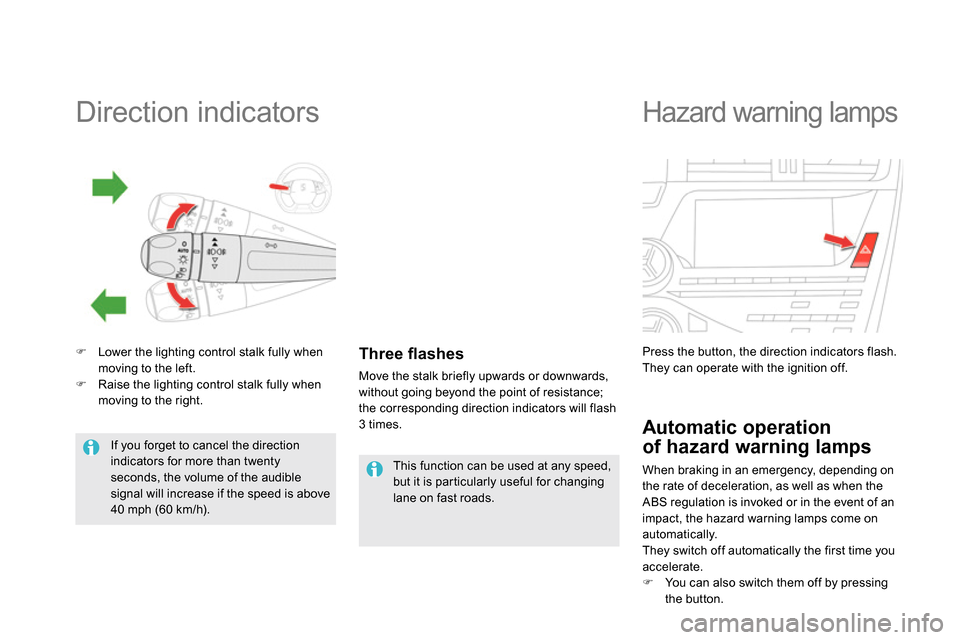
Direction indicators
Lower the lighting control stalk fully when
moving to the left.
Raise the lighting control stalk fully when
moving to the right.
Three fl ashes
Move the stalk briefly upwards or downwards,
without going beyond the point of resistance;
the corresponding direction indicators will flash
3 times.
If you forget to cancel the direction
indicators for more than twenty
seconds, the volume of the audible
signal will increase if the speed is above
40 mph (60 km/h).
Hazard warning lamps
Press the button, the direction indicators flash.
They can operate with the ignition off.
Automatic operation
of hazard warning lamps
When braking in an emergency, depending on
the rate of deceleration, as well as when the
ABS regulation is invoked or in the event of an
impact, the hazard warning lamps come on
automatically.
They switch off automatically the first time you
accelerate.
You can also switch them off by pressing
the button.
This function can be used at any speed,
but it is particularly useful for changing
lane on fast roads.
Page 183 of 372

181Safety
Horn
Emergency or
assistance call
This system allows you to make an emergency
or assistance call to the emergency ser vices or
to the dedicated CITROËN ser vice. Audible warning system to alert other road
users to an imminent danger.
Press the central part of the multifunction
steering wheel.
Use the horn moderately and only in the
following circumstances:
- immediate danger,
- overtaking a cyclist or pedestrian
- approaching a location lacking
visibility.
For more information on the use of
this function, refer to the "Audio and
telematics" section.
Page 184 of 372
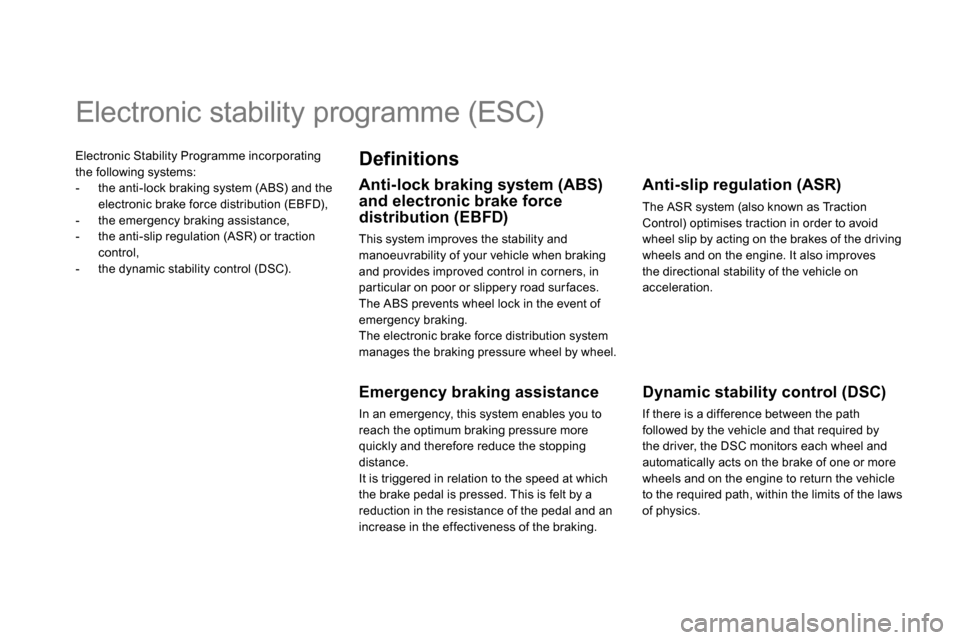
Electronic Stability Programme incorporating
the following systems:
- the anti-lock braking system (ABS) and the
electronic brake force distribution (EBFD),
- the emergency braking assistance,
- the anti-slip regulation (ASR) or traction
control,
- the dynamic stability control (DSC).
Electronic stability programme (ESC)
Definitions
Anti-lock braking system (ABS)
and electronic brake force
distribution (EBFD)
This system improves the stability and
manoeuvrability of your vehicle when braking
and provides improved control in corners, in
particular on poor or slippery road sur faces.
The ABS prevents wheel lock in the event of
emergency braking.
The electronic brake force distribution system
manages the braking pressure wheel by wheel.
Emergency braking assistance
In an emergency, this system enables you to
reach the optimum braking pressure more
quickly and therefore reduce the stopping
distance.
It is triggered in relation to the speed at which
the brake pedal is pressed. This is felt by a
reduction in the resistance of the pedal and an
increase in the effectiveness of the braking.
Anti-slip regulation (ASR)
The ASR system (also known as Traction
Control) optimises traction in order to avoid
wheel slip by acting on the brakes of the driving
wheels and on the engine. It also improves
the directional stability of the vehicle on
acceleration.
Dynamic stability control (DSC)
If there is a difference between the path
followed by the vehicle and that required by
the driver, the DSC monitors each wheel and
automatically acts on the brake of one or more
wheels and on the engine to return the vehicle
to the required path, within the limits of the laws
of physics.
Page 185 of 372

183Safety
Intelligent traction control
system ("Snow motion")
Your vehicle has a system to help driving on
snow: intelligent traction control.
This system detects situations of difficult
sur face adhesion that could make it difficult to
move off or make progress on deep fresh snow
or compacted snow.
In these situations, the intelligent traction
control
limits the amount of wheel slip to
provide the best traction and trajectory control
for your vehicle.
In extremely severe conditions (deep snow,
mud, ...), when it proves impossible to move off,
it may be useful to temporarily deactivate the
ESP/ASR systems to allow the wheels to spin
freely and so allow movement of the vehicle.
Operation
Anti-lock braking system (ABS)
and electronic brake force
distribution (EBFD)
In emergency braking, press
ver y firmly without releasing the
pressure.
When changing wheels (tyres and rims),
make sure that these are approved for
your vehicle.
Normal operation of the ABS may make
itself felt by slight vibrations of the brake
pedal. When this warning lamp comes on,
accompanied by an audible signal
and a message, it indicates that
there is a fault with the ABS, which
could cause loss of control of the vehicle when
braking.
When this warning lamp comes on,
coupled with the STOP
warning
lamp, accompanied by an audible
signal and a message, it indicates
that there is a fault with the electronic brake
force distribution (EBFD), which could cause
loss of control of the vehicle when braking.
You must stop as soon as it is safe to do so.
In both cases, contact a CITROËN dealer or a
qualified workshop.
The use of snow tyres is strongly
recommended on sur faces offering low levels
of adhesion.
Page 186 of 372
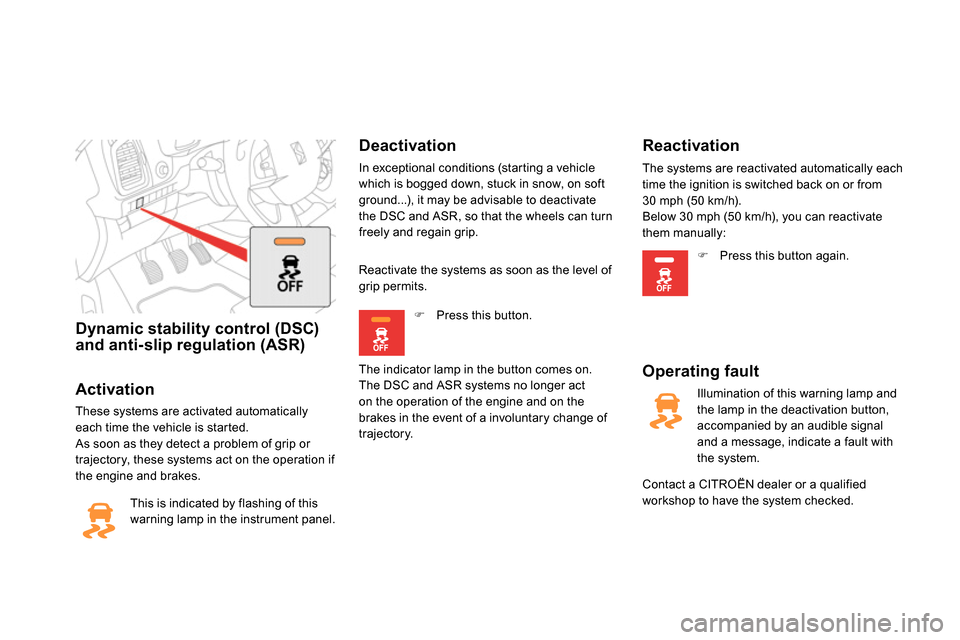
Dynamic stability control (DSC)
and anti-slip regulation (ASR)
Activation
These systems are activated automatically
each time the vehicle is started.
As soon as they detect a problem of grip or
trajectory, these systems act on the operation if
the engine and brakes.
This is indicated by flashing of this
warning lamp in the instrument panel.
Deactivation
Operating fault
Illumination of this warning lamp and
the lamp in the deactivation button,
accompanied by an audible signal
and a message, indicate a fault with
the system.
Reactivation
Press this button.
The indicator lamp in the button comes on.
The DSC and ASR systems no longer act
on the operation of the engine and on the
brakes in the event of a involuntary change of
trajectory.
Press this button again.
Reactivate the systems as soon as the level of
grip permits.
Contact a CITROËN dealer or a qualified
workshop to have the system checked. In exceptional conditions (starting a vehicle
which is bogged down, stuck in snow, on soft
ground...), it may be advisable to deactivate
the DSC and ASR, so that the wheels can turn
freely and regain grip. The systems are reactivated automatically each
time the ignition is switched back on or from
30 mph (50 km/h).
Below 30 mph (50 km/h), you can reactivate
them manually:
Page 187 of 372

185Safety
DSC/ASR
The DSC and ASR systems offer increased
safety in normal driving, but they should not
encourage the driver to take extra risks or
drive at high speed.
It is in conditions of reduced grip (rain,
snow, ice) that the risk of loss of grip
increases. It is therefore important for your
safety to keep the DSC and ASR systems
activated in all conditions, and particularly
in difficult conditions.
After an impact, have these systems
checked by a CITROËN dealer or a
qualified workshop.
The correct operation of these systems
depends on obser vation of the
manufacturer's recommendations regarding
as much the wheels (tyres and rims),
braking and electronic components as the
assembly and repair procedures used by
CITROËN dealers.
To benefit in full from the effectiveness
of the DSC and ASR systems in wintry
conditions, the vehicle must be fitted with
four snow tyres, allowing the the vehicle to
retain neutral behaviour on the road.
Page 188 of 372

Seat belts
Front seat belts
Rear seat belts
The rear seats are each fitted with a seat belt,
three-point anchorages with inertia reel and
force limiter (except for the centre rear seat).
Fastening
Pull the strap, then insert the tongue in the
buckle.
Check that the seat belt is fastened
correctly by pulling the strap.
Unfastening
Press the red button on the buckle.
Guide the seat belt as it reels in.
The front seat belts are fitted with a
pretensioning and force limiting system.
This system improves safety in the front
seats in the event of a front or side impact.
Depending on the severity of the impact, the
pretensioning system instantly tightens the seat
belts against the body of the occupants.
The pretensioning seat belts are active when
the ignition is on.
The force limiter reduces the pressure of the
seat belt on the chest of the occupant,
so improving their protection.
Page 189 of 372
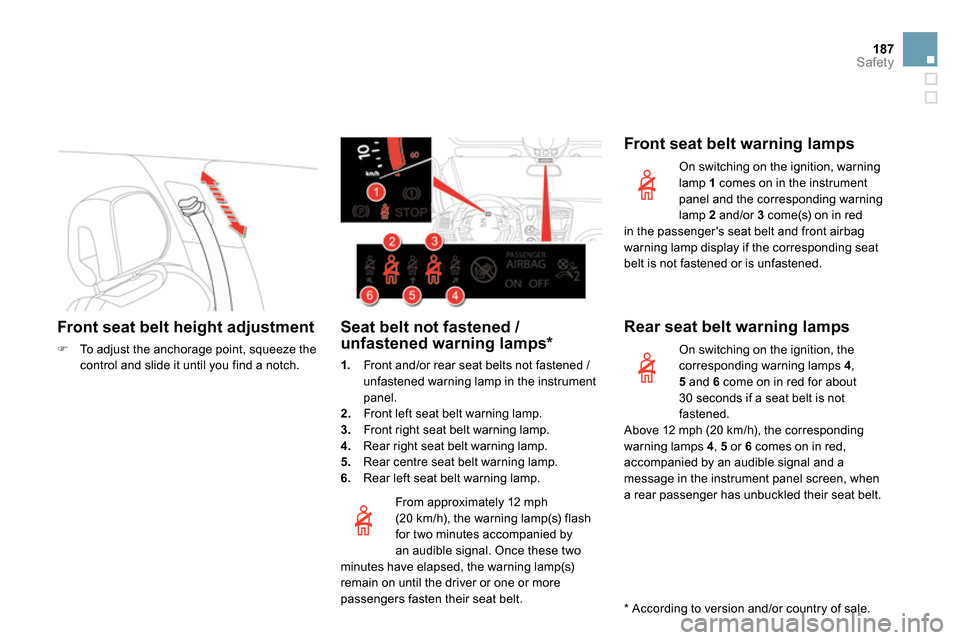
187Safety
Front seat belt height adjustment
To adjust the anchorage point, squeeze the
control and slide it until you find a notch.
From approximately 12 mph
(20 km/h), the warning lamp(s) flash
for two minutes accompanied by
an audible signal. Once these two
minutes have elapsed, the warning lamp(s)
remain on until the driver or one or more
passengers fasten their seat belt.
Seat belt not fastened /
unfastened warning lamps *
1.
Front and/or rear seat belts not fastened /
unfastened warning lamp in the instrument
panel.
2.
Front left seat belt warning lamp.
3.
Front right seat belt warning lamp.
4.
Rear right seat belt warning lamp.
5.
Rear centre seat belt warning lamp.
6.
Rear left seat belt warning lamp.
Front seat belt warning lamps
On switching on the ignition, warning
lamp 1
comes on in the instrument
panel and the corresponding warning
lamp 2
and/or 3
come(s) on in red
in the passenger's seat belt and front airbag
warning lamp display if the corresponding seat
belt is not fastened or is unfastened.
Rear seat belt warning lamps
On switching on the ignition, the
corresponding warning lamps 4
,
5
and 6
come on in red for about
30 seconds if a seat belt is not
fastened.
Above 12 mph (20 km/h), the corresponding
warning lamps 4
, 5
or 6
comes on in red,
accompanied by an audible signal and a
message in the instrument panel screen, when
a rear passenger has unbuckled their seat belt.
* According to version and/or country of sale.
Page 190 of 372
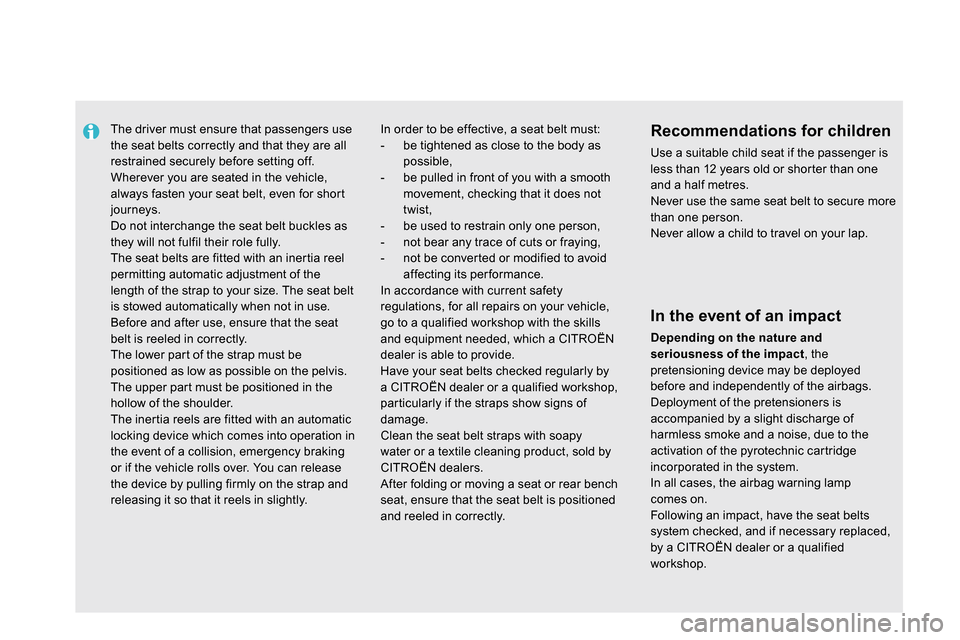
The driver must ensure that passengers use
the seat belts correctly and that they are all
restrained securely before setting off.
Wherever you are seated in the vehicle,
always fasten your seat belt, even for short
journeys.
Do not interchange the seat belt buckles as
they will not fulfil their role fully.
The seat belts are fitted with an inertia reel
permitting automatic adjustment of the
length of the strap to your size. The seat belt
is stowed automatically when not in use.
Before and after use, ensure that the seat
belt is reeled in correctly.
The lower part of the strap must be
positioned as low as possible on the pelvis.
The upper part must be positioned in the
hollow of the shoulder.
The inertia reels are fitted with an automatic
locking device which comes into operation in
the event of a collision, emergency braking
or if the vehicle rolls over. You can release
the device by pulling firmly on the strap and
releasing it so that it reels in slightly.
Recommendations for children
Use a suitable child seat if the passenger is
less than 12 years old or shorter than one
and a half metres.
Never use the same seat belt to secure more
than one person.
Never allow a child to travel on your lap. In order to be effective, a seat belt must:
- be tightened as close to the body as
possible,
- be pulled in front of you with a smooth
movement, checking that it does not
twist,
- be used to restrain only one person,
- not bear any trace of cuts or fraying,
- not be converted or modified to avoid
affecting its per formance.
In accordance with current safety
regulations, for all repairs on your vehicle,
go to a qualified workshop with the skills
and equipment needed, which a CITROËN
dealer is able to provide.
Have your seat belts checked regularly by
a CITROËN dealer or a qualified workshop,
particularly if the straps show signs of
damage.
Clean the seat belt straps with soapy
water or a textile cleaning product, sold by
CITROËN dealers.
After folding or moving a seat or rear bench
seat, ensure that the seat belt is positioned
and reeled in correctly.
In the event of an impact
Depending on the nature and
seriousness of the impact
, the
pretensioning device may be deployed
before and independently of the airbags.
Deployment of the pretensioners is
accompanied by a slight discharge of
harmless smoke and a noise, due to the
activation of the pyrotechnic cartridge
incorporated in the system.
In all cases, the airbag warning lamp
comes on.
Following an impact, have the seat belts
system checked, and if necessary replaced,
by a CITROËN dealer or a qualified
workshop.